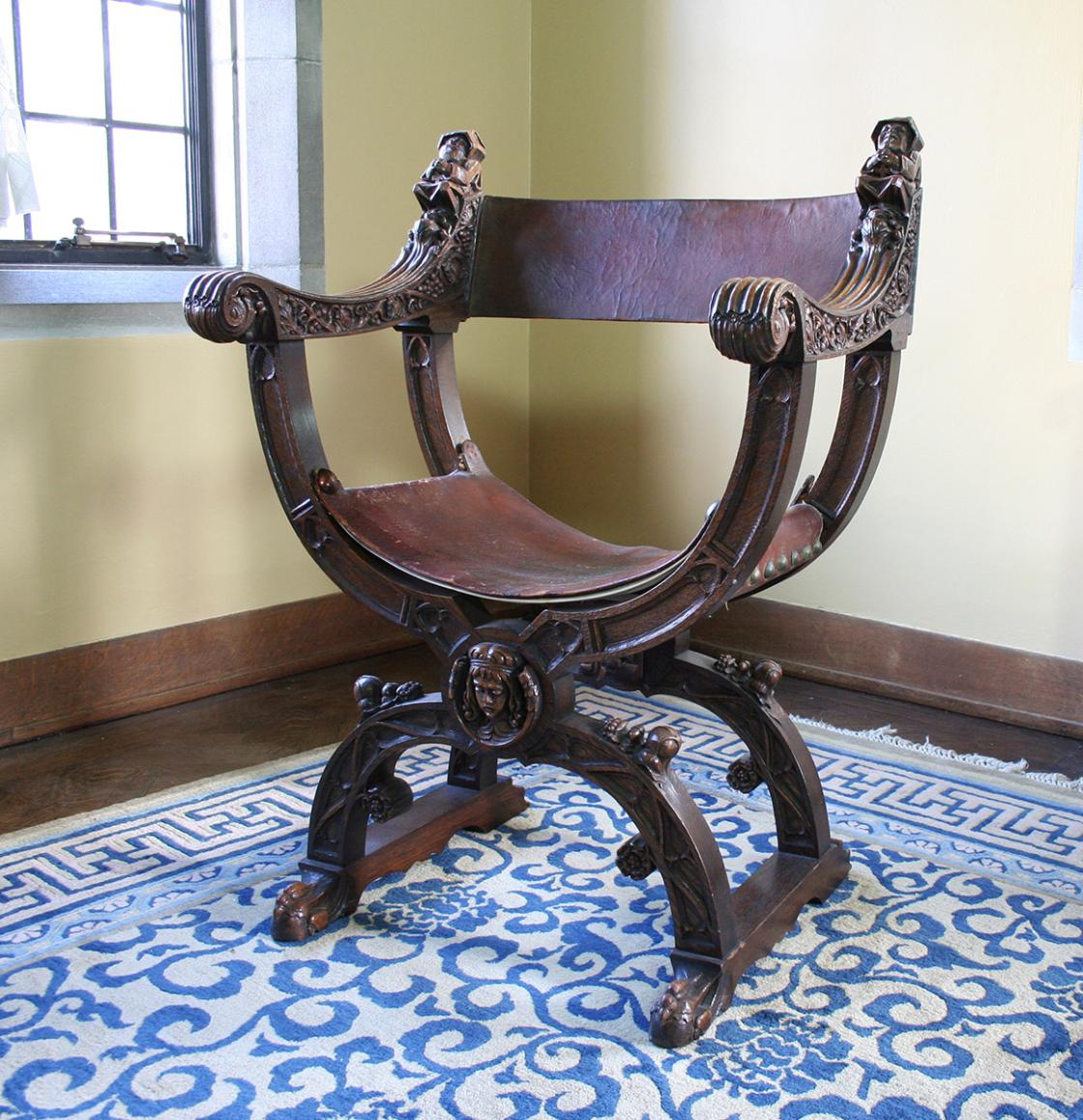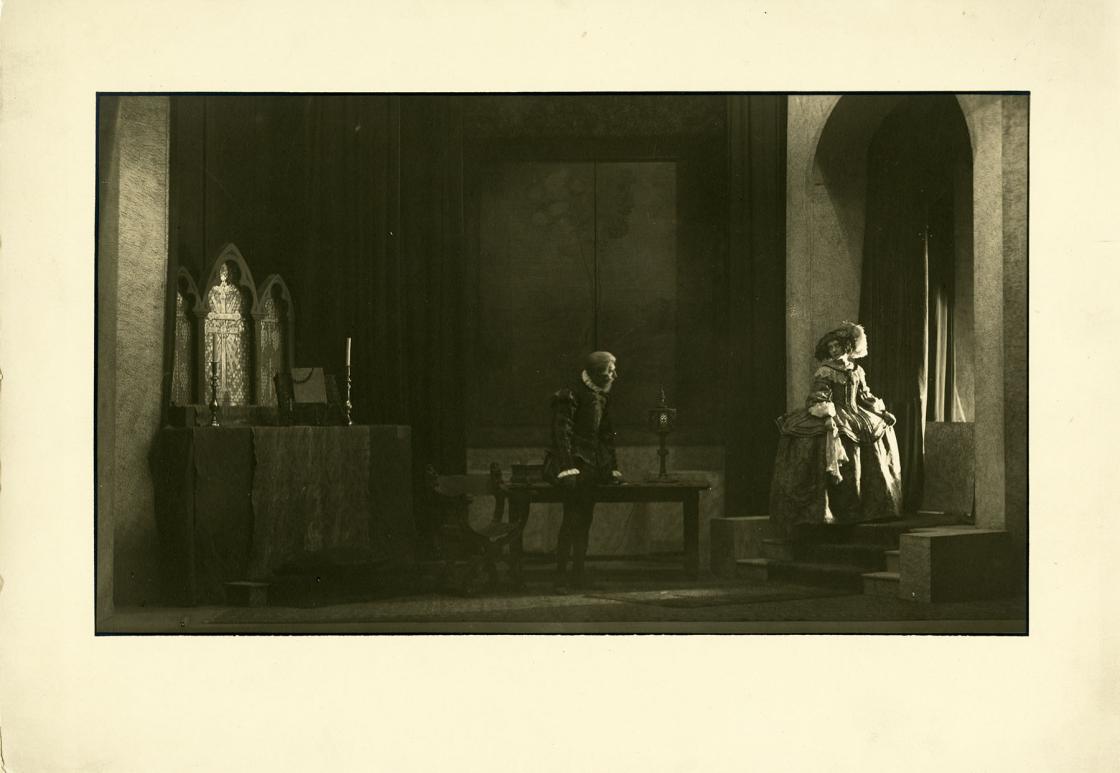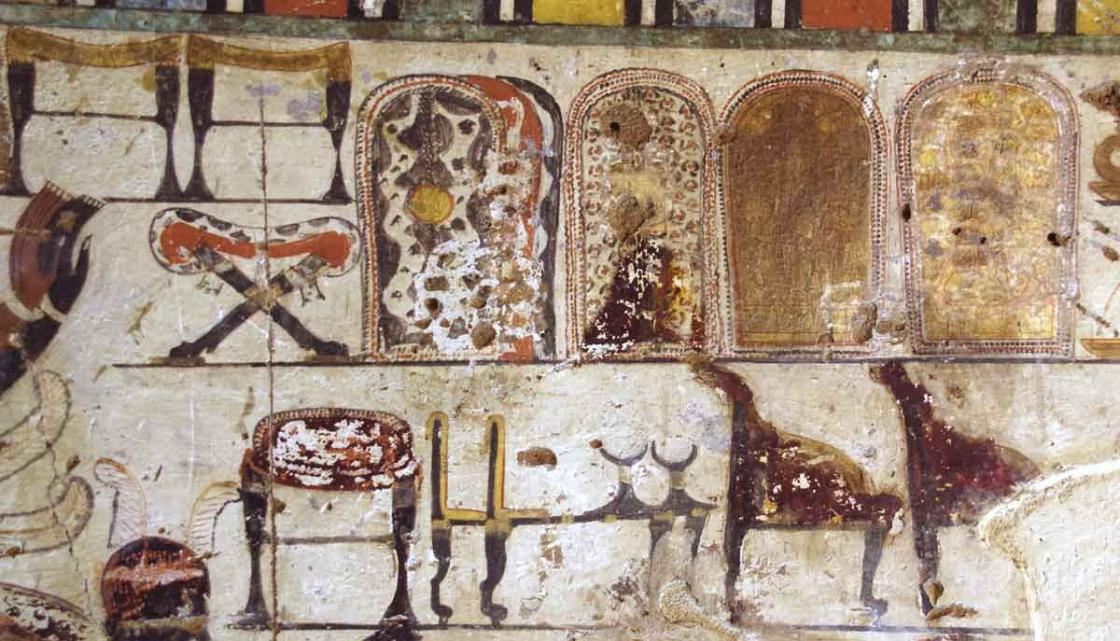“Savonarola” Chair
Wood and leather
38-1/4 x 20-1/2 x 22 inches
Johann (John) Kirchmayer (Designer)
(Born 1860, Oberammergau, Bavaria, Germany; died 1930, Boston, Massachusetts)
Cultural Properties Collection, Cranbrook House
Bequest of George Gough Booth and Ellen Scripps Booth to The Cranbrook Foundation

Cranbrook’s “Savonarola” Chair is attributed to Johannes (John) Kirchmayer, a founding member of the Boston Society of Arts and Crafts. It was used by the Detroit Society of Arts and Craft’s (DSAC) Little Theatre group in the 1918 production of John Masefield’s “Philip the King,” and again in Christopher Marlowe’s “Dr. Faustus.” While we do not know exactly when George Booth acquired the chair from the DSAC, by 1921 it was located in his office in Cranbrook House. In 1933 the chair was a prominent feature in the Oak Room before finding its permanent home in the Still Room where it can be seen today.
Born in Oberammergau, Bavaria, Kirchmayer studied sculpture and attended the University of Munich before he emigrated in 1880 to Boston and became known as an ecclesiastical sculptor in the American Gothic style. He was employed by the Boston woodcarving firm Irving & Casson before working for the William F. Ross Company. George Booth became acquainted with Kirchmayer around 1908 through architects Albert Kahn and Ralph Adams Cram. Cram designed St. Paul’s Cathedral in Detroit for which Kirchmayer carved the re-redos. Over the next twenty years, Booth acquired several of Kirchmayer’s pieces and commissioned his work for Brookside School’s Meeting House, Christ Church Cranbrook and Cranbrook House.

Folding seats or “scissors chairs,” like the “Savonarola” Chair, have a long history, dating back to at least 1567 B.C. during the New Kingdom of dynasties in Egypt. The early Egyptian folding stool, designed as a portable piece of furniture, was constructed from a pair of wooden frames with a slung leather seat. Wall paintings in the Tomb of Amenhotep Huy (ruler of Lower Nubia Kush under King Tutankhamun) document the use of the folding stool during this period.
The use of the folding chair was adopted by the Romans and was known as a “curule” chair. It was treasured by the commanders of Roman armies as practical, comfortable, and portable for use on long campaigns to the distant edges of the empire. The name “curule” refers to the “sella curulis” or the “chair of the office” reserved for use by Roman officials, particularly when they were seated in public. The earliest images of these chairs can be found on ancient Roman coins.
In 2003, archaeologists discovered a folding chair in a seventh-century Saxon burial chamber at Prittlewell, Essex, England. Professor Martin Carver of the University of York stated:
“For me, the most exciting object is the folding chair, and that’s because I associate much of Anglo-Saxon with camping and adventure, with horse, tent and boat. The folding chair is a perfect way of lending occasion to an outdoor meeting such as must have been commonplace around the sixth and early seventh centuries.”[i]

The “Savonarola” Chair evolved from this type of portable camp stool. The backs and seats of these chairs were usually upholstered with velvet, silk, or leather and often embroidered. The chairs could be crafted from wood, bronze, or iron. They are often referred to as an "X" chair or “scissors chair” because of the curved frame which crosses at the central joint. The name “Savonarola” (the most common name for the chair)* derives from a chair found in the convent of San Marco in Florence which was used by the 15th century Italian Dominican priest Girolamo Savonarola.
** A “Dante” chair, a heavier version of the X-form chair, does not fold.
Leslie S. Edwards, Former Head Archivist
Cranbrook Archives
sources
[i] The Newsletter of the Sutton Hoo Society, No. 40/2004, p. 2 (http://suttonhoo.org/wp-content/uploads/2016/02/Saxon40.pdf)
photo credits
Cranbrook’s “Savonarola” Chair, 2006. Mira Burack, photographer. Courtesy Cranbrook Archives.
“Philip the King,” 1918, Detroit Society of Arts and Crafts. Courtesy Cranbrook Archives.
Wall painting in the Transverse Hall, Tomb of Huy. ©Thierry Benderitter/www.osirisnet.net.
Links
http://cdm16296.contentdm.oclc.org/cdm/singleitem/collection/p9024coll2/id/3334/rec/3
http://www.vroma.org/images/mcmanus_images/tib_aug_coin2.jpg
http://detroitcathedral.org/wp2015/the-woodwork-of-the-cathedral/
